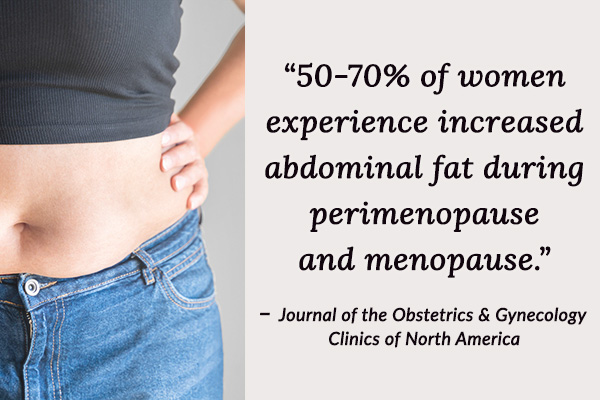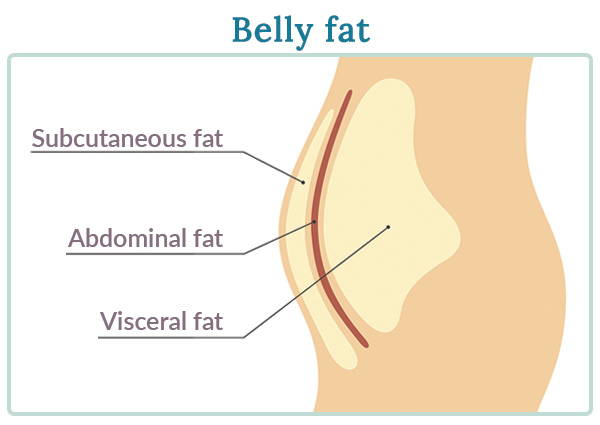Authored by Dr. Mary James, ND
Calorie restriction and strenuous exercise don’t do much to budge stubborn midsection weight gain in perimenopause. So, what does?
You may be surprised to learn that the secret to losing a “menopause belly” is actually fairly simple. First, you need to address the underlying hormonal imbalance driving this different kind of fat accumulation. When you do, your body can finally let go of the weight. And you can look and feel the way you want.

The cause of meno belly is in your hormones
During perimenopause and menopause, women’s hormone levels are in a state of major flux. Estrogen may be dropping but also spiking. In this state of instability and imbalance, hormonal or metabolic imbalances that were once simmering invisibly on the back burner can start making themselves known.
Estrogen fluctuations trigger hormonally active visceral fat
One of estrogen’s actions is to deposit subcutaneous fat onto your hips. As estrogen levels fluctuate in perimenopause, that signal weakens and fat deposition shifts to the abdomen. This midsection weight (aka meno belly fat) is different because it contains visceral fat. This is fat that accumulates deep within the abdominal cavity. Visceral fat is hormonally active, exacerbating existing hormonal imbalances and making the hormonal roller coaster of perimenopause an even bumpier ride.

If you already have noticed the appearance of menopause belly fat, consider this a flashing red flag. You need to focus on balancing your reproductive hormones, starting now. The easiest way to restore healthy and balanced hormonal ratios is with time-tested herbs and other natural compounds that provide adaptogenic support to respond to your body’s unique hormonal needs. Our Herbal Equilibrium formula has helped thousands of women restore balance to hormones and release hormonal weight.
Cortisol: the stress hormone that accelerates belly fat
It’s not just reproductive hormones that lead to belly fat deposition. Belly fat contains receptors for cortisol, our body’s main stress hormone. When we’re stressed our adrenals release cortisol. This stimulates these belly fat receptors — resulting in the formation of even more belly fat.
Keep in mind that stress is also a potent trigger for inflammation. Chronic inflammation alone can make it hard to lose added weight. It inhibits some enzymes that normally break down fats in the body.
Constantly feeling stressed out may seem like the norm in today’s fast-paced society. But that does not mean that it’s healthy. To tame your cortisol levels, do whatever works for you to slow down and de-stress: unplug, delegate, meditate, stretch and relax. Taking a high quality adrenal supplement also helps to support balanced cortisol levels.

Insulin resistance is a trigger for meno belly weight gain
Insulin is a powerful hormone that regulates blood sugar metabolism in the body. Chronic stress and abdominal fat can encourage insulin resistance, in which cells aren’t able to work with the hormone to use glucose for energy. When cells aren’t able to take in glucose, the body more easily turns these calories into fat — even if you’re dieting.
The good news is you can do something about insulin resistance. Strength training to build muscle also boosts your metabolism and makes those insulin receptors more sensitive, helping you to lose weight. Ever notice how men tend to lose weight more easily than women? It’s because they have more lean muscle mass.
Chronic sleep problems affect appetite-regulating hormones
Is perimenopause robbing you of sleep by causing night sweats and making you wake up at odd hours of the night? Is your system still too wired at bedtime to get into sleep mode?
Chronic sleep deficits — whatever the cause — can promote weight gain. This is because of the effects that sleep has on two hormones that regulate appetite. When you get enough sleep your body releases leptin, a hormone that controls appetite. Not enough sleep means a bigger release of ghrelin, a hormone that literally makes you crave junk food!
You may feel like you just have lousy self-discipline when in fact it’s your body chemistry that’s making it more difficult to eat healthy and to know when to stop. Whatever it takes, really try to make sure you get enough sleep at night.
Foods to eat — and foods to avoid — to support meno belly weight loss
You’ve probably noticed that crash diets don’t work to budge menopause belly fat — no matter how much you restrict calories. The reason for this when you’re in perimenopause is that weight loss is more complex than “calories in/calories out.” To be successful a meno belly diet requires the added step of focusing meals and snacks around foods that help restore and maintain hormonal balance.
Meno belly diet: 6 key steps to shed midsection weight gain
- Cut the sugar. When your hormones are out of balance in perimenopause, balancing your hormones and optimizing your overall health are virtual requirements for losing unwanted weight and belly fat. Sugar is a trigger for hormonal imbalance, so keep it to a bare minimum in your diet by eliminating sugary processed foods which are notorious for containing large amounts of added sugar as well as unhealthy fats that also harm hormones. If you’re craving something sweet, snack on a serving of fresh fruit. Apples, pomegranates and cherries are considered superfoods for hormonal health because they contain hormone-friendly compounds that can improve hormonal balance — and satisfy your sweet tooth.
- Eat foods that lower inflammation. As you go through the menopause transition, increasing oxidative damage throughout the body can trigger chronic inflammation. Science tells us again and again that there’s a direct link between chronic inflammation and difficulties with shedding excess weight. You can stop this chain reaction and protect your body from oxidative stress by increasing your intake of antioxidant-rich foods. These include: broccoli, spinach, carrots, artichokes, cabbage, asparagus, avocados, beetroot, radish, lettuce, sweet potatoes, kale, nuts and even dark chocolate.
- Fill your meno belly diet with fiber. When your body is in a state of hormonal balance it is making hormones in the correct ratios, but it is also metabolizing and excreting these hormones to keep the entire endocrine system humming along. To help promote healthy estrogen metabolism, eat more fiber. As studies have shown, high fiber diets promote healthy estrogen levels by helping the body to excrete excess amounts of the hormone. This is especially important for women with estrogen dominance. High fiber foods include dark green veggies, brown rice, oats, millet, root vegetables and seeds.
- Pack enough protein. Eating protein provides your body with amino acids, which in turn function as the building blocks of hormones, including estrogen, insulin and thyroid hormones. Protein in meals and snacks also helps to stabilize insulin levels, leading to more even energy levels throughout the day (something that makes sticking to a diet a little easier). To support healthy hormonal balance, aim to eat about 20-25 grams of protein at every meal and about 10-15 grams with a snack.
- Eat for symptom relief. Foods rich in iron and calcium can be helpful for relief of mood swings, hot flashes and other common menopause symptoms. When you have fewer menopause symptoms, you can get enough sleep (without hot flashes keeping you awake) and better support your body in losing weight. Meat, fish, eggs, beans and lentils are good sources for both these nutrients. Foods to exclude or limit because they can trigger hot flashes and other symptoms include alcohol and caffeine.
- Supplement with medicinal herbs. Certain herbs and other plant medicines have been used for centuries to effectively balance women’s hormones, especially during perimenopause and menopause. These aren’t your usual culinary herbs, so to reap the benefits, look for an herb-based nutritional supplement that can address your particular mix of hormonal symptoms.
Best exercises for shedding meno belly fat
The good news is that losing a meno belly doesn’t require long, strenuous workouts. In fact, working out at too high an intensity can stress the body and trigger added cortisol production. The best forms of exercise for shedding meno belly fat are those that energize the body and work muscles at a more moderate level. Here are four exercises to try:
Walking. As simple as it gets, going for a brisk 20-30 minute walk on most days of the week is a cardio workout that relieves stress, gently works your muscles and lifts your aerobic output, helping you burn calories and belly fat. You can walk indoors on a treadmill, but try to get outside. Sunshine’s added Vitamin D boost helps your body maintain hormonal balance.
Yoga. Practicing yoga helps to calm your mind and reduce cortisol, helping to prevent this major stress hormone from “feeding” more belly fat. It’s also a great whole body exercise for core muscle toning and balance.
Swimming and water aerobics. If your knees and other joints tend to hurt during exercise, try swimming and water aerobics. The buoyancy of water takes pressure off your joints, giving you the ability to exercise without pain. Plus, the added resistance of water gives your workout more muscle-strengthening power.
Strength training. Engage in exercises that focus on the major muscle groups — your arms, legs and core. Try a strength-training exercise like Pilates or hit the gym for a more traditional workout with weights. Regular strength training can help you reduce body fat, strengthen your muscles and burn calories more efficiently.
With so many approaches to try, here’s the encouraging message: just because that meno belly fat hasn’t budged lately doesn’t mean that it won’t when you try a different approach!
 | Want even more new ideas for stopping hormonal weight gain? Read our article: Demystifying perimenopausal weight gain. |













